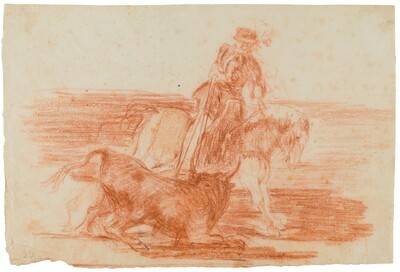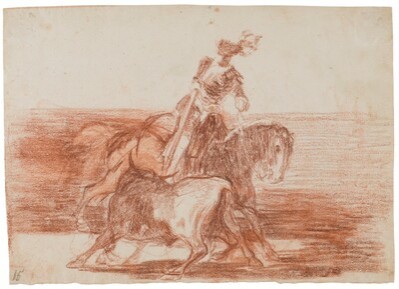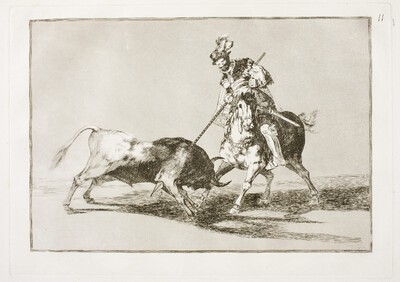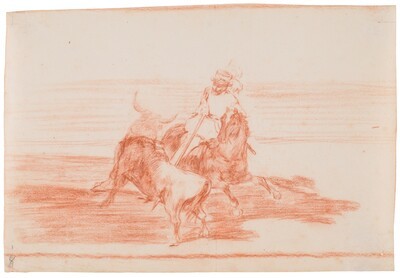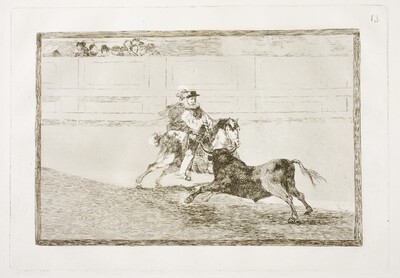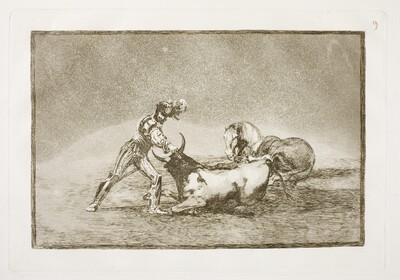- Cronología
- 1814 - 1816
- Dimensiones
- 250 x 351 mm
- Técnica y soporte
- Aguafuerte, aguatinta, punta seca, buril y bruñidor
- Reconocimiento de la autoría de Goya
- Documented work
- Ficha: realización/revisión
- 01 Oct 2021 / 22 Jun 2023
- Inventario
- -
10 (print, upper right-hand corner)
Goya (vertical, embossed, lower left-hand corner)
See How the ancient Spaniards hunted bulls on horseback in the countryside
There is a state proof, made before aquatint and burnisher, in the Dutuit collection, Musée du Petit Palais, Paris.
The plate is kept at the National Chalcography.
See How the ancient Spaniards hunted bulls on horseback in the countryside
The print is part of the subgroup, composed of four prints, dedicated to the origin and chivalrous nature of bullfighting on horseback (nos. 9-11 and 13). Perhaps it corresponds to a historical event referred to both by Nicolás Fernández de Moratín ('Historical Letter...') and by Pepe Hillo ('Bullfighting...') and José Vargas Ponce ('Dissertation...'), which took place in July 1527 during the festivities organised in Valladolid to celebrate the birth of the heir of the Emperor Charles V (Charles I of Spain), the future King Philip II.
This is a very dynamic composition for which Goya made three preparatory drawings with variations in pose and lighting, although the print is very simple, with the two protagonists standing out against a neutral background, without spatial references and worked only with tonal gradations of aquatint: the rider on his mount and the bull, facing in opposite directions. The bull, with his back to the spectator, turns his head towards the horse, and the rider, raised in the stirrups and slightly bent over for extra strength, lances the bull while holding the bridle of his mount.
Sayre emphasises the theatrical effect achieved with the play of light and shadow in the aquatint.
Several authors have pointed out the anachronism of Charles V's clothing, citing the custom of fighting in old-fashioned dress, and some have stressed the fact that Goya places this picture before that of the Cid, which would break the chronological order of the events depicted.
-
Grabados y dibujos de Goya en la Biblioteca NacionalBiblioteca NacionalMadrid1946catalogue Elena Páez Ríos
-
Goya en la Biblioteca Nacional. Exposición de grabados y dibujos en el sesquicentenario de su muerteBiblioteca NacionalMadrid1978May - June 1978
-
Grabados de Goya: colección propiedad de la Biblioteca Nacional, que se conserva en su Gabinete deCasa de la Amistad de MoscúMoscow1979exhibition displayed from January 18th to 31st 1979
-
Goya. Das Zeitalter der Revolucionen. Kunst um 1800 (1980 – 1981)Hamburger KunsthalleHamburg1980cat. 262
-
1984
-
Madrid1987
-
Goya: toros y torerosEspace Van GoghArles1990displayed also at Academia de Bellas Artes de San Fernando, Madrid, consultant editor Pierre Gassier.cat. 24
-
Goya grabadorFundación Juan MarchMadrid1994consultant editors Alfonso E. Pérez Sánchez and Julián Gállego, from January 14th to March 20th 1994
-
Goya grabadorMuseo del Grabado Español ContemporáneoMarbella1996from March 8th to May 5th 1996
-
Zaragoza1996
-
Schlaf der Vernunft. Original radierungen von Francisco de GoyaMunich2000
-
Madrid2002
-
Madrid2002
-
Bilbao2012
-
Goya et la modernitéPinacothèque de ParisParís2013from October 11st 2013 to March 16th 2014cat. 26
-
Zaragoza2017
-
1946pp. 177-216, espec. pp. 185 y 191-192
-
OxfordBruno Cassirer1964vol. II, 1964, pp. 323-324, cat. 213
-
Vie et ouvre de Francisco de GoyaParísOffice du livre1970p. 277, cat. 1167
-
The Changing image: Prints by Francisco GoyaBostonMuseum of Fine Arts1974pp. 218-221, cat. 170-173
-
Goya, Das Zeitalter de Revolutionen. 1789-1830HamburgPrestel-Verlag Münche und Hamburger Kunsthalle1980p. 296
-
Goya, toros y torerosMadridMinisterio de Cultura, Comunidad de Madrid1990p. 93
-
MadridCaser-Turner1992pp. 30 y 39
-
MadridMuseo Nacional del Prado2001pp. 56-58
-
ParísPinacoteca de París2013p. 104
-
Goya. In the Norton Simon MuseumPasadenaNorton Simon Museum2016pp. 186-201

